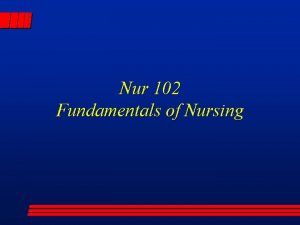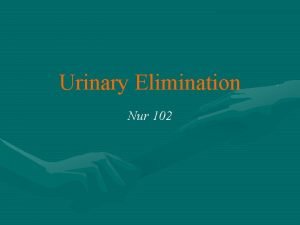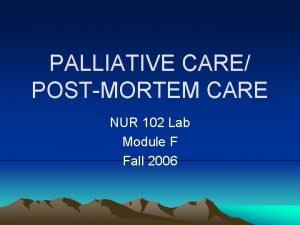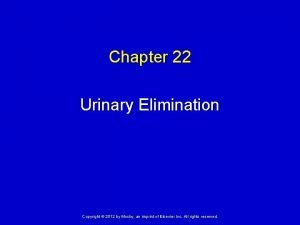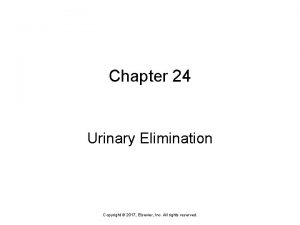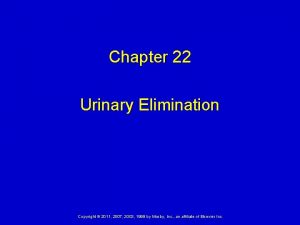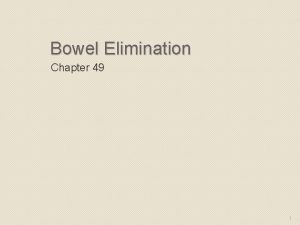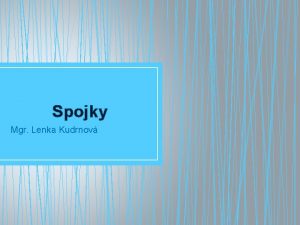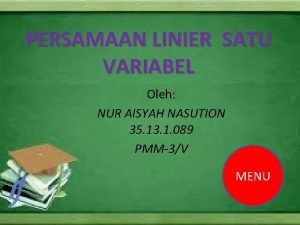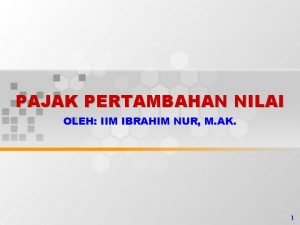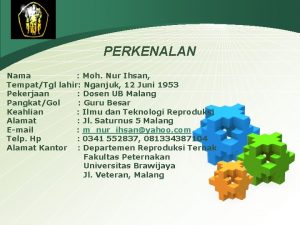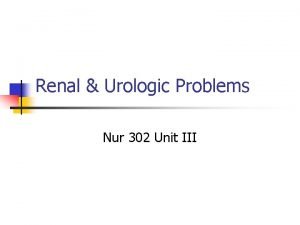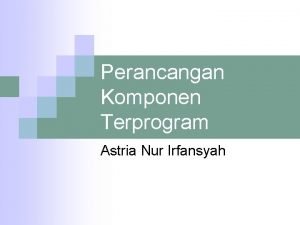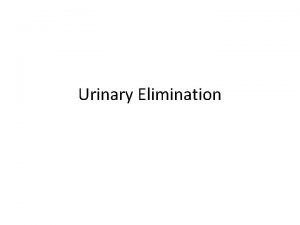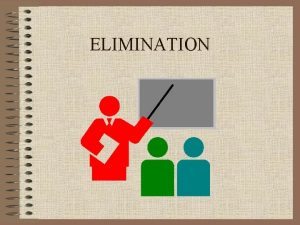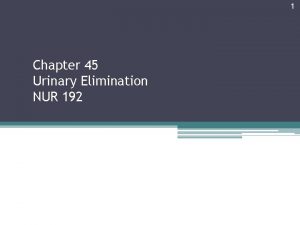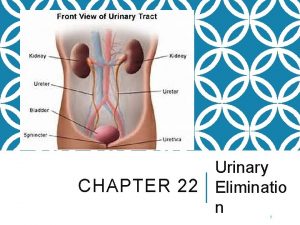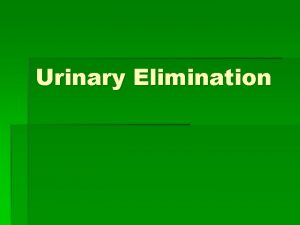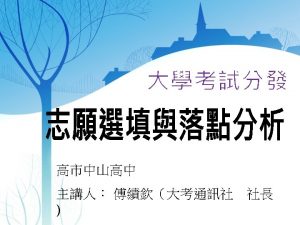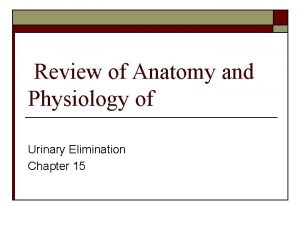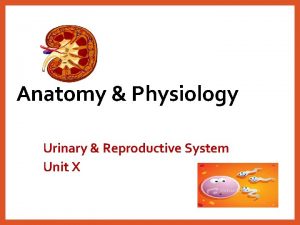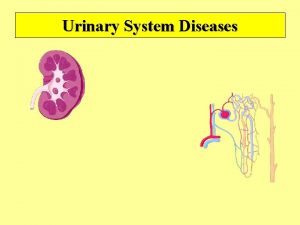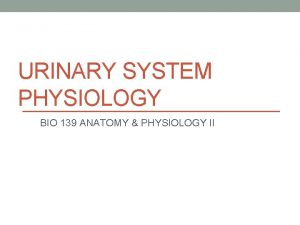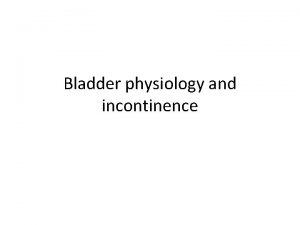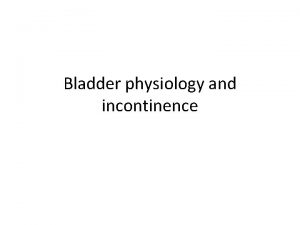Urinary Elimination Nur 102 Physiology of Urinary Elimination




















- Slides: 20

Urinary Elimination Nur 102

Physiology of Urinary Elimination • Kidneys: primary regulators of fluid and acid-base balance • Ureters • Urinary bladder: reservoir for urine • Urethra

Urination • Urination, micturation, and voiding: Are all refer to the process of emptying the urinary bladder. • Urine collects in the bladder until pressure stimulate the stretch receptors which occurs when bladder contain 250 -450 ml of urine in adult & 50 -200 ml in children • Stretch receptors transmit impulse to the voiding reflex center in the spinal cord (2 -4 Sacral Vertebrae) causing internal sphincter to relax and stimulate the urge to void.

Urination • If the time and place are suitable the cerebral cortex relaxes the external Urethral sphincter muscle and micturation occur. • The process of Urination is under voluntary and involuntary control. • Voluntary control is possible if the nerves of bladder and urethra, the neural tracts of the cord and brain, the motor area of the cerebrum are all intact.

Factors Affecting Voiding 1. Developmental Factors (Age): Which affect the amount, frequency, urine concentration (kidney function) and control of voiding. 2. Psychological Factors: Privacy, normal position, sufficient time, and running water are enhancing the process of micturation. On the other hand other stressful condition may cause anxiety and muscle tension which diminish micturation. 3. Fluid and food intake.

4. Medication: such as Diuretics. 5. Muscle Tone: good muscle tone is important to maintain the stretch and contractility of the bladder. Retention catheters that are used for long period of time drain urine so prevent bladder from filling and emptying normally. 6. Pathological Condition: Renal failure (RF), and heart failure decreases the urine formation, kidney and ureters stones may obstruct the urinary flow. Prostate enlargement. 7. Surgical and diagnostic procedures: such as cystoscopy, spinal anesthesia decrease the sensation for urination.

Altered Urine Production 1. Polyuria or Diuresis: Ø Ø Ø Is the production of abnormally large amounts of urine by the kidneys. Can cause excessive fluid loss, dehydration and weight loss. Associated with excessive fluid intake (polydipsia), DM, Diabetes insipidus, chronic nephritis.

2. Oliguria and Anuria: Decrease urinary output. Ø Oliguria is low urine output usually less than 500 ml/day or 30 ml/hr, Ø may occur due to abnormal fluid losses or lack of fluid intake. Ø it indicates impaired blood flow to the kidney or impending RF. Ø Anuria refer to a lack of urine production less than 50 ml/day Ø When the kidneys become unable to function, some mechanisms of filtering the blood is necessary to prevent illness and death. Ø Dialysis: removing the fluid and molecules using artificial techniques (Hemodialysis and peritoneal dialysis).

Altered Urinary Elimination Normal urine production but the problem is in the elimination: 1. Frequency and Nocturia Ø Urinary frequency is voiding more than 4 -6 times/day, due to increase intake, UTI, stress, and pregnancy can cause frequent voiding of small quantities. Ø Nocturia is voiding 2 or more times at night

2. Urgency Ø is the sudden strong desire to void regardless of the amount of urine to void. May be due to stress or irritation of urethra, poor external sphincter control, and unstable bladder contraction. 3. Dysuria Ø painful or difficult voiding. Due to stricture of the urethra, UTI, and injury to bladder and urethra. May cause urinary hesitancy (delay or difficulty in initiating voiding).

3. Enuresis is involuntary urination in children beyond the age when voluntary bladder control is normally acquired (4 -5 yrs). Ø Nocturnal (at night) enuresis: affect boys more than girls Ø Diurnal (daytime) enuresis: affect women and girls more frequently. 4. Urinary incontinence (UI) Ø Involuntary leakage of urine or loss of bladder control. May be due to UTI, urethritis, pregnancy, hypercalcemia, volume overload, restricted mobility, stool impaction, multiple vaginal birth and neurological disorders. Lead to Isolation, social withdrawal, and embarrassment.

5. Urinary Retention Ø Inability to empty the bladder completely so the bladder become overdistended which cause poor contractility of the bladder. Due to Prostate hypertrophy, Surgeries, and some medications (antihistamine, anticholinargeic) 6. Neurogenic Bladder Ø Impaired neurologic function of the bladder which affect the process of elimination. No awareness of bladder fullness, and unable to control the urinary sphincters. The bladder become flaccid and distended or spastic, with frequent involuntary urination, occur in spinal cord disease and brain tumor.

Nursing Management Assessment 1. 2. 3. 4. 5. 6. Nursing History: Normal voiding pattern, frequency, appearance of the urine, any past or current urination problem. Physical assessment: tenderness, dullness over distended bladder, assess skin color, turgor, edema Assessing Urine: color (straw, amber, transparent), odor, sterility, acidity (4. 5 -8), specific gravity (1. 010 -1. 025), glucose, ketone bodies, blood Measuring Urinary output Measuring Residual Urine: < 100 ml Diagnostic test: KFT, 24 hrs creatinine clearance test, U/A routine and culture, specific gravity, Direct visualization (Cystoscopy), Ultrasound (KUB), and X rays.

Nursing Diagnosis 1. Impaired Urinary Elimination: dysfunction in urine elimination 2. Functional Urinary Incontinence 3. Reflex Urinary incontinence 4. Stress Urinary incontinence 5. Urge urinary incontinence 6. Urinary retention Associated Nursing Diagnosis: - Risk for Infection - Low Self-esteem Impaired skin integrity - fluid volume deficit or excess, Knowledge deficit

Planning Goals: l Maintain or restore a normal voiding pattern l Regain normal urine output l Prevent associated risk l Perform toilet activities independently with or without assistive device objective: pt will be able to demonstrate kegel exercise during my shift pt will be able to show 24 hr’s intake and output balance

Implementation 1. Maintaining Normal Urinary elimination: 1 -1 Promote fluid intake: – – – Give daily requirement of fluid (1500 ml/day) Increase fluid intake as required (hot weather, at risk for UTI, Calculi formation (2000 -3500 ml/day) to increase urination Decrease fluid intake in case of RF, or HF to prevent edema. 1 -2 Maintain Normal Voiding Habits: – Help the pt to adhere to normal voiding pattern as much as possible. 1 -3. Assisting with toileting:

2. Preventing Urinary Tract Infection: most common Nosocomial infection, mostly caused by bacteria from GIT. Greater in women than men Ø Ø Ø Ø Drink 8 glasses of water per day to flush bacteria Avoiding tight fitting pants that irritate urethra. Wear cotton rather than nylon underclothes to prevent moisture. Girls and women should always wipe the perineal from front to back In recurrent UTI, take always showers rather than baths Increase intake of vit C to increase urine acidity Practice frequency voiding Q 2 -4 hr’s

3. Managing Urinary Incontinence: 3 -1 Continence (bladder) training program: – – Education of the client and support people. Bladder training: postpone voiding, resist or inhibit the sensation of urgency, and void according to a timetable rather than sensation to urge. Habit training: timed voiding or schedule regular intervals but no attempt to motivate the client to delay voiding if the urge occur (effective in children) Prompted Voiding: encouraging the client to try to use the toilet (prompting) and reminding the client when to void.

3 -2 Pelvic Muscle Exercises (PME) or Kegel exercises: Tightening the perineal muscles by stopping urination mid stream. Contract perineal muscles any time and anywhere. Avoiding contraction of the buttocks and thigh muscles. 3 -3 Maintaining Skin integrity: - Wash perineal area with mild soap and rinse thoroughly with water, then dry - Provide clean and dry clothes and bed linen - Place draw sheet under the pt 3 -4 Applying External Urinary Drainage Device: as condom

4. Managing Urinary Retention: Ø All previous measures apply for retention, if unsuccessful, may use medications. Ø Cholinergic drug such as Urecholine to stimulate bladder contraction & facilitate voiding. Ø Manual pressure on the bladder to promote bladder emptying (Crede’s maneuver) used in client with a flaccid bladder Ø Urinary Catheterization: Can cause UTI, trauma for the urethra 5. Urinary Diversions: Surgical rerouting of urine from kidney to site other than the bladder (e. g. ureterostomy, nephrostomy)
 Nur 102
Nur 102 Nur 102
Nur 102 Impaired urinary elimination
Impaired urinary elimination Nur 102
Nur 102 Alteration in urinary elimination
Alteration in urinary elimination Chapter 22 urinary elimination
Chapter 22 urinary elimination Chapter 24 urinary elimination
Chapter 24 urinary elimination Chapter 22 urinary elimination
Chapter 22 urinary elimination Physiology of bowel elimination
Physiology of bowel elimination Gauss elimination vs gauss jordan
Gauss elimination vs gauss jordan Gcg menurut para ahli
Gcg menurut para ahli Wer nur ein einziges leben rettet rettet die ganze welt
Wer nur ein einziges leben rettet rettet die ganze welt Oder slovosled
Oder slovosled Penyelesaian pada persamaan 16m = 64 adalah
Penyelesaian pada persamaan 16m = 64 adalah Man kann den menschen nur vor den kopf schauen
Man kann den menschen nur vor den kopf schauen 10 gebote zum glücklichsein
10 gebote zum glücklichsein Iim ibrahim nur
Iim ibrahim nur Nur masripatin
Nur masripatin Logo nur ihsan
Logo nur ihsan Nur 302
Nur 302 Astria nur irfansyah
Astria nur irfansyah

